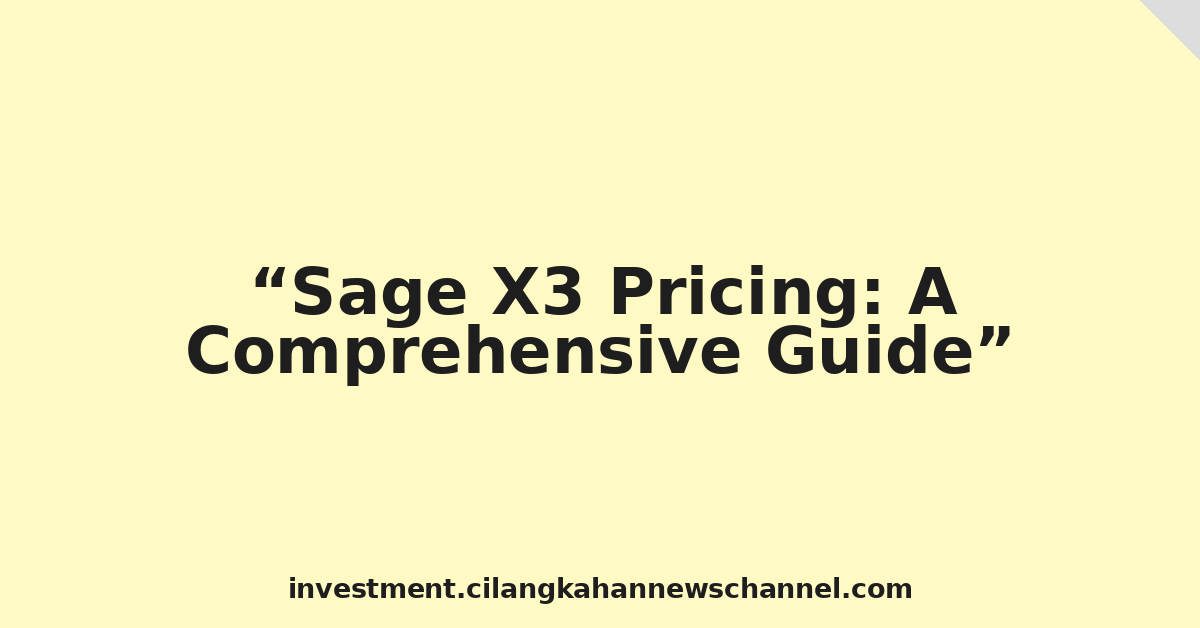Understanding the cost of an Enterprise Resource Planning (ERP) system like Sage X3 is crucial for businesses considering its implementation. Sage X3, a mid-market ERP solution, offers a range of functionalities designed to streamline operations and improve efficiency across various departments. However, its pricing structure isn’t as straightforward as a simple per-user fee. Instead, it’s influenced by several factors, making it essential to understand these nuances before making a purchasing decision. This comprehensive guide will delve into the various aspects of Sage X3 pricing, helping you navigate the process and make an informed choice.
Hello Reader investment.cilangkahannewschannel.com, before we dive into the specifics, it’s important to understand that Sage X3 pricing isn’t publicly listed like a consumer product. There’s no fixed price list available online. The cost is determined through a customized quote based on your specific business needs and requirements. This personalized approach ensures that you only pay for the features and functionalities you actually need, avoiding unnecessary expenses.
Factors Influencing Sage X3 Pricing:
Several key factors significantly impact the final cost of Sage X3. These include:
-
Number of Users: This is a fundamental factor. The more users who require access to the system, the higher the cost. Sage X3 pricing typically involves a per-user licensing fee, although this can be structured in different ways, such as tiered pricing based on user roles and access levels.
-
Modules Required: Sage X3 offers a modular architecture, allowing businesses to select only the modules they need. Choosing a wider range of modules, such as financial management, supply chain management, customer relationship management (CRM), manufacturing, and project management, will naturally increase the overall cost. A smaller business might only need core financial modules, while a larger, more complex organization might require a comprehensive suite of functionalities.
-
Implementation Services: Implementing an ERP system is a complex process that often requires professional services. Sage X3 implementation costs can vary significantly depending on the complexity of your business processes, the level of customization required, and the expertise of the implementation partner. This can include project management, data migration, system configuration, training, and ongoing support. These services are typically charged separately and can represent a substantial portion of the total cost.
-
Customization: While Sage X3 offers a robust standard functionality, businesses often require customizations to align the system with their unique workflows and processes. These customizations can add to the overall cost, both in terms of development time and ongoing maintenance. It’s crucial to carefully evaluate the need for customizations and balance the benefits against the additional expenses.
-
Hardware and Infrastructure: Depending on your business’s infrastructure setup, you might need to invest in new hardware or cloud services to support Sage X3. This can include servers, network infrastructure, and data storage. The cost of hardware and infrastructure can vary significantly depending on the size and complexity of your business. Cloud-based deployments can often reduce upfront hardware costs but may involve ongoing subscription fees.
-
Support and Maintenance: Ongoing support and maintenance are essential for ensuring the smooth operation of your Sage X3 system. This typically includes technical support, software updates, and bug fixes. These services are usually offered as a separate subscription and are an ongoing expense.
-
Training: Proper training is crucial for ensuring user adoption and maximizing the return on investment (ROI) of your Sage X3 implementation. The cost of training will depend on the number of users and the complexity of the modules they will be using. Consider the value of effective training and budget accordingly.
Pricing Models:
While Sage X3 doesn’t publicly advertise its pricing, several common pricing models are used by ERP vendors, and it’s likely Sage utilizes a combination of these:
-
Subscription-Based Licensing: This model involves paying a recurring monthly or annual fee for access to the software. This is becoming increasingly common, offering predictable budgeting and access to regular updates.
-
Per-User Licensing: This model charges a fee for each user who accesses the system. The cost per user can vary depending on the modules they access and their user role.
-
One-Time License Fee: This model involves a single upfront payment for a perpetual license to use the software. However, this typically doesn’t include ongoing maintenance and support, which are usually charged separately.
-
Tiered Pricing: Sage might offer different pricing tiers based on the number of users, modules, or functionalities included. Higher tiers offer more features and capabilities at a higher cost.
Estimating the Cost:
Getting an accurate estimate for Sage X3 requires engaging with a Sage reseller or partner. They will conduct a thorough needs assessment, understanding your business processes, requirements, and the number of users. Based on this assessment, they will provide a customized quote that includes all the relevant costs, including software licensing, implementation services, customization, hardware, support, and training.
It’s crucial to be transparent about your business needs and budget during this process. Don’t hesitate to ask detailed questions about the pricing breakdown and any hidden costs. Comparing quotes from multiple resellers is also advisable to ensure you’re getting the best possible value.
Conclusion:
Sage X3 pricing is a complex subject that requires careful consideration. There’s no single answer to the question "How much does Sage X3 cost?" The final price depends on a multitude of factors specific to your business. By understanding these factors and engaging with Sage resellers proactively, you can obtain a clear and accurate estimate, allowing you to make an informed decision about whether Sage X3 is the right ERP solution for your organization and whether its cost aligns with your budget and ROI expectations. Remember to factor in all associated costs, including implementation, training, customization, and ongoing maintenance, to create a comprehensive budget. The investment in a robust ERP system like Sage X3 can significantly improve your business efficiency and profitability in the long run, making a thorough cost analysis essential for success.

